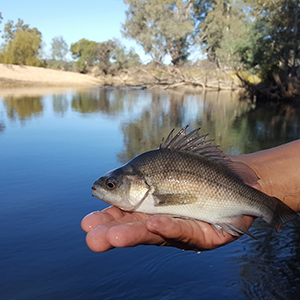Larval fish sensitivity to a simulated cold-water pulse varies between species and age

Accepted: 27 June 2022
Supplementary: 161
HTML: 135
All claims expressed in this article are solely those of the authors and do not necessarily represent those of their affiliated organizations, or those of the publisher, the editors and the reviewers. Any product that may be evaluated in this article or claim that may be made by its manufacturer is not guaranteed or endorsed by the publisher.
Authors
The release of cold-water from hypolimnetic zones of impoundments sharply reduces downstream riverine water temperature. This cold-water pollution (CWP) can extend for hundreds of kilometres, severely challenging the physiological ability of aquatic fauna, particularly ectotherms such as fish, to maintain essential processes such as metabolism, development and growth and survival. The impact of CWP on native fish, especially early life stages, is poorly known. We investigated the effect of a 24-hour exposure to a range of environmentally-related water temperatures (8, 10, 12, 14, 16, 18 and 20°C) on three age-classes (<24-hour-old, 7-day and 14-day-old larvae) of two Australian native fish species: Murray cod (Maccullochella peelii) and Macquarie perch (Macquaria australasica). Overall, larvae of M. peelii were more sensitive to lower water temperatures and hence CWP than M. australasica, indicated by higher rates of equilibrium loss. Larvae of M. peelii were most sensitive to exposure at seven days old whereas M. australasica larvae were most sensitive at <24-h-old. Using our results, we modelled pre- and post-impoundment temperature scenarios and estimated the downstream CWP footprint for both species in an Australian river reach. Larvae of M. peelii were predicted to be absent from the first 26 km of river downstream of the impoundment compared with no impact on the distribution of M. australasica. Managing riverine water temperature below impoundments is fundamental to promoting positive outcomes for endemic fish on not only a local, but global basis. This study emphasises the differential impact of CWP among the critical early life stages and fish species and highlights the urgent need to better manage hypolimnetic water releases to improve downstream river ecosystems.
Edited by
Pietro Volta, CNR-IRSA Verbania, ItalyHow to Cite

This work is licensed under a Creative Commons Attribution-NonCommercial 4.0 International License.
Similar Articles
- Renata Trevisan, Marco Picarella, Frank B. Dazzo, Stefano Bona, Giuseppe Morabito, Andrea Squartini, Using a morpho-functional approach to assess phytoplankton dynamics in two adjacent high-mountain lakes: a 10-year survey , Journal of Limnology: Vol. 73 No. 3 (2014)
- Ruben Ladrera, Miguel Cañedo-Argüelles, Narcís Prat, Impact of potash mining in streams: the Llobregat basin (northeast Spain) as a case study , Journal of Limnology: Vol. 76 No. 2 (2017)
- Päivi Rinta, David Bastviken, Jos Schilder, Maarten van Hardenbroek, Tabea Stötter, Oliver Heiri, Higher late summer methane emission from central than northern European lakes , Journal of Limnology: Vol. 76 No. 1 (2017)
- Man Zhang, Qiu-Qi Lin, Li-Juan Xiao, Sheng Wang, Xin Qian, Bo-Ping Han, Effect of intensive epilimnetic withdrawal on phytoplankton community in a (sub)tropical deep reservoir , Journal of Limnology: Vol. 72 No. 3 (2013)
- Hortência de Souza Barroso, Janaina A. Santos, Rozane V. Marins, Luiz Drude Lacerda, Assessing temporal and spatial variability of phytoplankton composition in a large reservoir in the Brazilian northeastern region under intense drought conditions , Journal of Limnology: Vol. 77 No. 1 (2018)
- Piero Guilizzoni, Suzanne N. Levine, Marina Manca, Aldo Marchetto, Andrea Lami, Walter Ambrosetti, Achim Brauer, Stefano Gerli, Elisabetta A. Carrara, Angelo Rolla, Licia Guzzella, Davide A.L. Vignati, Ecological effects of multiple stressors on a deep lake (Lago Maggiore, Italy) integrating neo and palaeolimnological approaches , Journal of Limnology: Vol. 71 No. 1 (2012)
- Juliana V. Rangel, Rosângela E.S. Araújo, Cinthia G. Casotti, Larissa C. Costa, Walace P. Kiffer Jr., Marcelo S. Moretti, Assessing the role of canopy cover on the colonization of phytotelmata by aquatic invertebrates: an experiment with the tank-bromeliad Aechmea lingulata , Journal of Limnology: Vol. 76 No. 2 (2017)
- Melaku Getachew, Seid Tiku Mereta, Geremew Sahlu Gebrie, Worku Legesse Mulat, Mary Kelly-Quinne, Impacts of the Koka hydropower dam on macroinvertebrate assemblages in the Awash River Basin in Ethiopia , Journal of Limnology: Vol. 82 (2023)
- Marco Pilotti, Giulia Valerio, Luca Gregorini, Luca Milanesi, Charlie A.R. Hogg, Study of tributary inflows in Lake Iseo with a rotating physical model , Journal of Limnology: Vol. 73 No. 1 (2014)
- Cristina Ribaudo, Marco Bartoli, Daniele Longhi, Simona Castaldi, Scott C. Neubauer, Pierluigi Viaroli, CO2 and CH4 fluxes across a Nuphar lutea (L.) Sm. stand , Journal of Limnology: Vol. 71 No. 1 (2012)
<< < 1 2 3 4 5 6 7 8 9 10 > >>
You may also start an advanced similarity search for this article.
-
John D. Koehn, Charles R. Todd, Henry Wootton, Michael JoyMarine and Freshwater Research : 2023

 https://doi.org/10.4081/jlimnol.2022.2056
https://doi.org/10.4081/jlimnol.2022.2056





